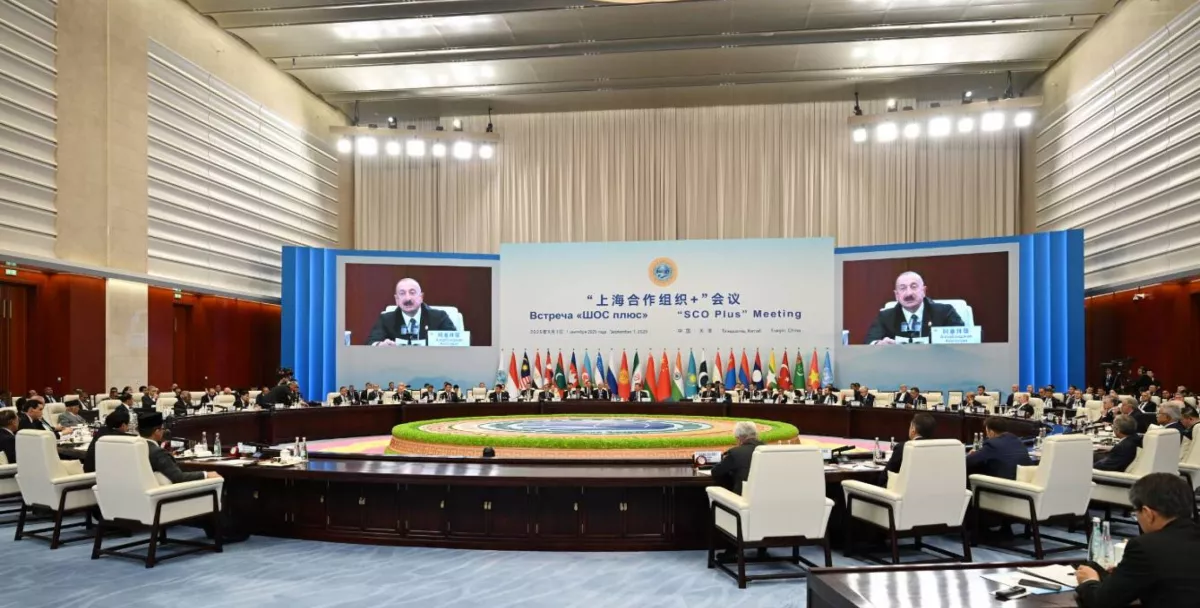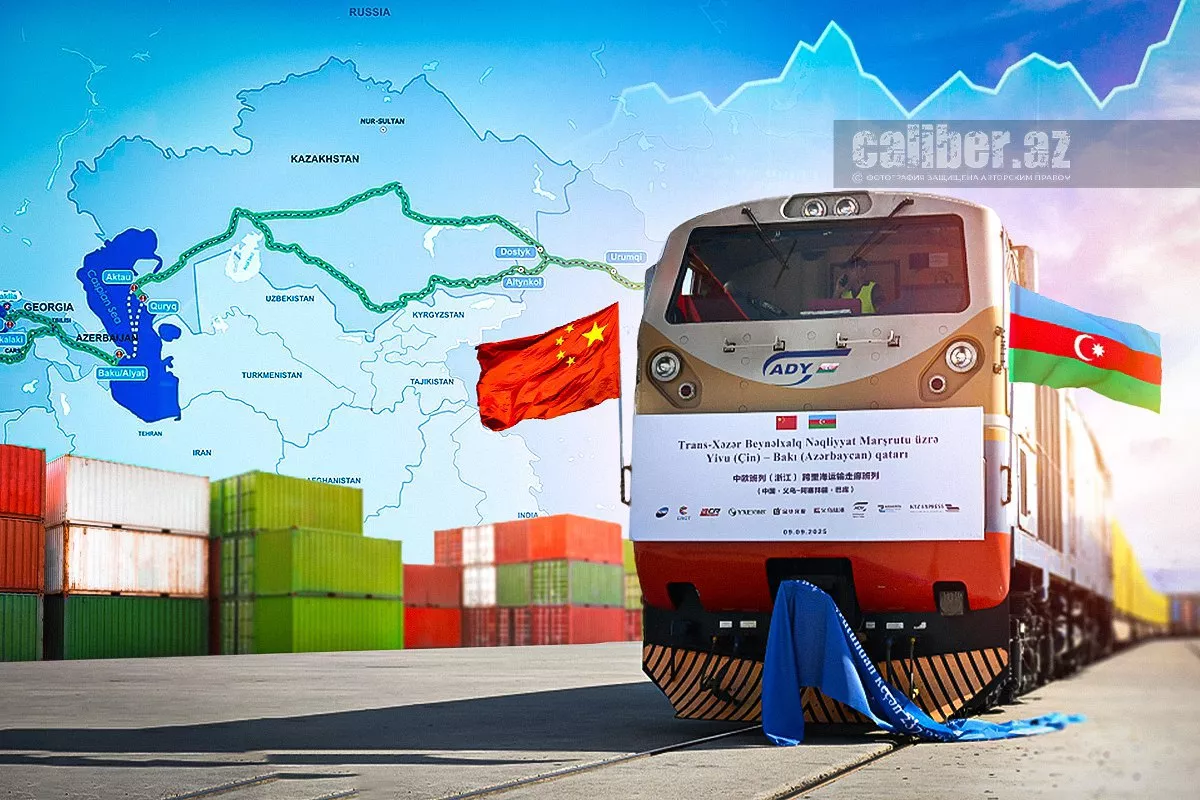Azerbaijan and China boost transport connectivity Bridging Europe and Asia
Trade and transit along the Trans-Caspian route, increasingly integrated with Chinese traffic through the Belt and Road Initiative, have been growing dynamically in recent years, drawing greater attention from global players to Azerbaijan. The strategic potential and significance of the Middle Corridor were emphasised by President Ilham Aliyev in his address to participants of the two-day forum on “Resonance of Development and Security: Regional Cooperation and Governance in the Institutional Transformation of CICA”, held on September 9 in Baku.
Transport and logistics issues were also highlighted at the Absheron Logistics Center during the event marking the fifth anniversary of the China–Europe rail express route, which included a ceremony to welcome the latest block train.
“Today, Asia is rapidly emerging as one of the world’s centers of power, both in terms of economic potential and its influence on global affairs,” said Azerbaijani President Ilham Aliyev in his address to participants of the forum, organised by the Center for Analysis of International Relations and the Shanghai Institute of International Studies.
In the statement read by Farid Shafiyev, Chairman of the Board of the Center for Analysis of International Relations, Azerbaijan’s efforts to develop logistical connectivity in the Asian region were highlighted. In particular, President Ilham Aliyev underscored that Baku’s peace-oriented agenda in the region opens new horizons in foreign policy, positioning Azerbaijan as one of the key transport and logistics hubs of Eurasia. President Aliyev expressed confidence that the Zangezur Corridor, as one of the routes of the Middle Corridor, will soon play the role of an important transport hub connecting continents.
The development of the Middle Corridor and the strengthening of transport and logistics connectivity—from China’s borders through Central Asia and the South Caucasus to Europe—were also among the main topics at the annual SCO summit, which opened on 31 August in Tianjin, China, and was attended by the Azerbaijani President.
“Since 2022, the volume of cargo traffic along the Middle Corridor through Azerbaijan has grown by almost 90 percent,” President Ilham Aliyev recently stated during a SCO+ meeting. “The Zangezur Corridor will soon become another important segment of the Middle Corridor, as well as the North-South Corridor, which will contribute to enhancing peace, multilateral partnership and benefit all of Azerbaijan's close and distant neighbors to the east, west, north and south of our borders.”

In particular, the logistics component, strengthened under China’s Belt and Road Initiative, and the large-scale transportation of Chinese goods through Azerbaijan via the Trans-Caspian International Transport Route (TITR) have become key drivers of the rapidly expanding Azerbaijan–China trade and business cooperation, shaping transport policy across the wider Eurasian region. The Middle Corridor provides Beijing with a direct and reliable overland route through Central Asia and Azerbaijan to European markets. Container block trains assembled in China and transported via the TITR reach Europe in approximately 20–25 days—roughly half the time of maritime shipments through the Suez Canal, which typically take 40–50 days. This efficiency is fuelling the growth of transit shipments from China via multimodal container block trains; last year, 358 container trains travelled from China to Europe along the TITR, and cargo throughput is expected to triple in the coming years.
During the ceremony in Baku welcoming the 237th block train operating along the TITR route (Yiwu–Baku), and as part of the event marking the fifth anniversary of the China (Zhejiang)–Europe rail express route held on September 9, officials from CJSC Azerbaijan Railways (ADY), representatives of the Ministry of Transport, and other relevant agencies participated.
“We met with a delegation led by Ke Jixin, Vice Governor of China’s Zhejiang Province, who is visiting Azerbaijan. During this event, we discussed logistics, the development of the Middle Corridor, and prospects for transportation along this route,” wrote Azerbaijani Minister of Digital Development and Transport Rashad Nabiyev on the social media platform X. “We also exchanged views on the digitalisation of logistics corridors.” The minister further announced an agreement to establish a working group to facilitate cooperation in automation and digitalisation between the Port of Ningbo in Zhejiang Province and the Baku International Sea Trade Port (BISMP).
“This year, 450 block trains are planned to be sent to China via Azerbaijan, and in the medium term, this figure could reach 1,000 block trains per year. We believe that, through the joint efforts of the two countries, this number will grow even further,” said Fariz Aliyev, Head of the Transport Policy Department at the Azerbaijani Ministry of Digital Development and Transport, during the event held on September 9.
The department head emphasised that Azerbaijan’s location along the strategic route of the “Great Silk Road” has created favourable conditions for the further development of trade, economic, cultural, and political ties between Azerbaijan and China. In recent years, cooperation between the two countries has reached the level of a strategic partnership, gaining both significant qualitative and quantitative depth. At the same time, Azerbaijan has become a crucial component of intercontinental transport and trade networks. According to the official, cargo shipments along the Middle Corridor in 2024 increased nearly fivefold compared to 2019: last year, 358 block trains were dispatched from China to Europe, underscoring Azerbaijan’s growing role within the Middle Corridor system.

Fariz Aliyev also reminded that the Zangezur Corridor, an important element of Azerbaijan’s transport system, is a strategically significant project for establishing transport links both along the east–west and north–south axes, as well as for facilitating transit cargo shipments. Work on developing the Zangezur Corridor within Azerbaijan is expected to be completed by 2026, while parallel projects are underway in Türkiye — the foundation of a 224-kilometre section of the Kars–Dilucu line has been laid, with full completion planned within the next four years. Once all segments of the corridor are operational, the TITR is expected to carry up to 15 million tonnes of cargo.
The construction of the cross-border international railway line Goris–Aghband is being financed from the Azerbaijani budget. To date, 76 km of the 110.4-kilometre single-track section, running through the Jabrayil and Zangilan districts to the border settlement of Aghband, have been completed. The plan envisions extending this railway through Armenian territory to the Nakhchivan Autonomous Republic (NAR), followed by connecting the tracks toward Kars in Türkiye. The implementation of these plans gained concrete momentum following the agreements reached on 8 August in Washington, mediated by U.S. President Donald Trump, between the Prime Minister of Armenia and the President of Azerbaijan on a peace agenda, as well as the accord on implementing the Trump Route for International Peace and Prosperity (TRIPP) project.
The implementation of the TRIPP project is seen as a key milestone for the development of cross-border routes in the South Caucasus. On the eve of this, the development of this vector was discussed during a meeting with representatives of the U.S. Certified Business Delegation to the Middle Corridor.
“During our meeting with representatives of the U.S. Certified Business Delegation to the Middle Corridor, we emphasized the importance of further advancing the Azerbaijan–US strategic partnership in order to diversify trade and energy routes along this vital corridor and to maximize economic benefits for the countries of the region,” wrote Azerbaijani Minister of Economy Mikayil Jabbarov on his social media page X. “We underlined Azerbaijan’s pivotal role as a transportation and transit hub, as well as the wide range of initiatives and infrastructure projects undertaken to enhance trade flows across the route connecting Europe and Asia. We also invited U.S. companies to take advantage of the favorable business and investment climate established in our country.”








